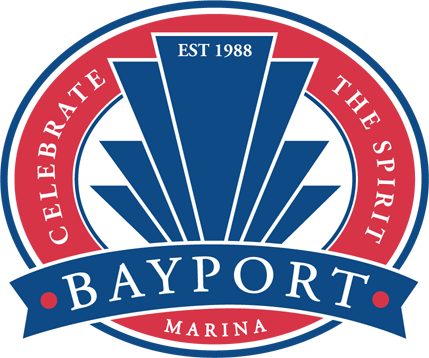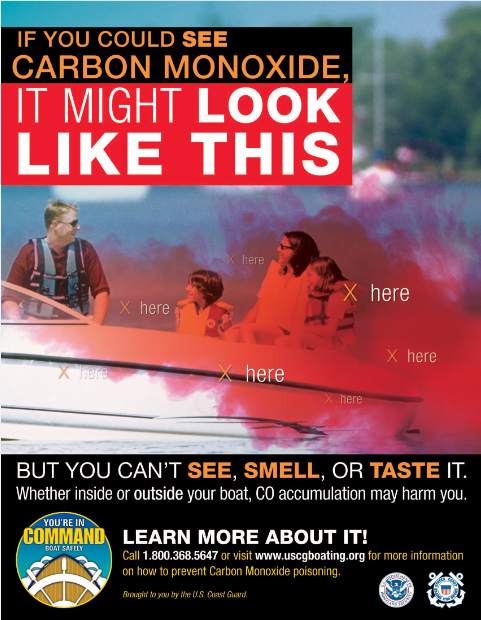Sophia’s Law
United States Coast Guard
Learn how this new carbon monoxide law will affect Minnesota boaters and save lives
“Sophia’s Law is named for seven-year-old Sophia Baechler, who died from carbon monoxide poisoning while boating on Lake Minnetonka. Carbon monoxide (CO) is an odorless, colorless, tasteless gas that can be toxic even in very small quantities since its effects are cumulative over time. Whether inside, outside, underway or anchored, passengers of many types of boats with a motor can quickly become victims of CO poisoning. A quick inspection every time you operate your boat can save a life, carbon monoxide poisonings are preventable.”
Sophia’s Law requires that all motorboats, regardless of fuel type, with an enclosed accommodation compartment must be equipped with a functioning marine CO detector system installed according to the manufacturer’s instructions. All gasoline-powered motorboats with any enclosed occupancy compartment must display the three CO warning stickers as directed by law.
These must be complete by May 1, 2017 for lawful operation.
To learn more, read through this fact sheet from the MN Department of Natural Resources. Please visit the Minnesota DNR’s website for more information on these new regulations.
Safe boating!
– The Bayport Marina Staff
Below are some common questions as well as their answers from the DNR website to help you learn more about this new law and any action that you should take to be in compliance:
I. What you need to know: Sophia’s Law requirements
Motorboats, regardless of fuel type, with an *enclosed accommodation compartment must be equipped with a functioning marine CO detector system installed according to the manufacturer’s instructions.
Per the American Boat and Yacht Council (ABYC) standard A-24 Carbon Monoxide Detection Systems, July 2015, detectors must be located to monitor the atmosphere in the main cabin and each sleeping area. Carbon monoxide detectors manufactured prior to 2012 should be replaced.
All gasoline-powered motorboats with any *enclosed occupancy compartment must display three CO poisoning warning stickers as directed by law.
These updates must be complete by May 1, 2017 for lawful operation.
Most boat owners affected by this law will receive the warning stickers and details on the requirements before boating season begins next year.
Minnesota is the first state to require CO detectors in motorboats. Together we can lead our nation in reducing CO poisoning accidents while boating.
*terms defined below
II. Does my motorboat need one or more CO detectors?
Motorboats, regardless of fuel type, must have a functioning marine CO detector if they have an enclosed accommodation compartment, which is defined as a motorboat with all of the following:
- Designated sleeping accommodations
- A galley area with a sink
- A head (toilet) compartment
Enclosed occupancy compartment is defined as:
One contiguous space surrounded by boat structure that may be occupied by a person
If your boat just has an occupancy compartment you are not required by law to have a CO detector in the space, however, it is highly recommended for the safety of all passengers that a detector be placed in any enclosed compartment.
Per the American Boat and Yacht Council (ABYC) standard A-24 Carbon Monoxide Detection Systems, July 2015, detectors must be located to monitor the atmosphere in the main cabin and each sleeping area. Supplementing with additional low level CO monitors will alert passengers sooner of the presence of carbon monoxide which can be harmful at low levels/under 30ppm.
III. Does my motorboat require the three warning stickers?
If you have a gasoline-powered motorboat with any enclosed space surrounded by boat structure intended for a person to enter, you are required to have the three CO warning stickers displayed. The appropriate sticker is to be placed:
- At the helm (steering station)
- In or at the entrance to any enclosed occupancy space
- At the aft boarding/stern area.
Although it is not required, motorboats with diesel engines are urged to display the stickers warning boaters of the dangers of CO poisoning especially if they also have generators or other fuel burning appliances.
IV. How do I get my warning stickers?
The DNR will mail the three warning stickers to all owners of boats 19′ or greater, even if they do not have a specified cabin. You can look for the stickers to be mailed prior to the 2017 boating season. Stickers will also be available, at no cost, at all deputy registrars and may be requested by local marinas, dealers, repair shops, etc.
The mailed stickers and included carbon monoxide information will help educate owners of motorboats about the danger of carbon monoxide.
V. Can I install any CO detector?
No, marine CO detectors must meet ABYC standard A-24, July 2015 which references Underwriters Laboratory (UL) standard UL2034 for marine use. Detectors must be listed for marine use which includes certification by an independent party.
VI. What about low-level monitors?
The required CO detectors come with the following warning: Individuals with medical problems may consider using warning devices, which provide audible and visual signals for CO concentrations under 30 PPM. These are known as low-level monitors/detectors.
Low-level monitors provide additional protection which is important to at-risk populations such as the very young, the elderly, and those with health concerns. They can be used in addition to the required detectors to provide early warning to low levels of carbon monoxide. They cannot be used as the only detectors as they are not designed for the harsh outdoor marine environment. Supplementing with a low-level CO detector will alert passengers of the presence of lower, but still harmful, levels of carbon monoxide.
VII. Can I install the CO detector myself?
We recommend that you have a marine technician install hard wired detectors. Miswired boats could be a fire hazard and could cause electric shock drowning when connected to an external power source. Electrical standards for boats are different than land-based standards. Installation must be as per manufacturer’s instructions.
VIII. I have a CO detector that was installed prior to 2012, is it still safe to use?
No, sensors within the CO detectors have an average life span of 5 years. Newer models have a printed expiration date or alert system notifying the user when to replace the system. Some new models have a longer life span.
IX. My boat is under 19 feet long, do I need to comply?
This law applies to all motorboats regardless of length that have the enclosed spaces. However, this fact sheet is only being sent to owners of motorboats 19-feet and greater. Owners of smaller boats with enclosed spaces will be able to get the stickers at a deputy registrar in the spring.
X. What is the penalty if I don’t comply in time?
The first violation will be a safety warning; additional violations are a petty misdemeanor.
XI. My motorboat does not have a fully enclosed space, what safety steps can I take?
All boaters are encouraged to display CO warning stickers at the steering station and on the stern even if not required by law. If your motorboat has a three-sided enclosure or you operate with a canvas enclosure, please install a CO detector and warning stickers for the safety of your passengers and yourself. If your boat is diesel powered it is also in best practice to display the CO warning stickers.
XII. What if I have an out-of-state or documented boat?
The law applies to any motorboat, with the spaces defined above, operating on Minnesota waters. This includes the Minnesota side of boarder waters and federal waters within the state. A motorboat includes sailboats with motors and documented boats.
For more on how to protect yourself from the dangers of carbon monoxide while boating please visit the following websites:
For information on how to get a free vessel safety check, visit www.vesselsafetycheck.org or contact your local U.S. Coast Guard Auxiliary or United States Power Squadrons. Additional questions, please call the DNR Boat and Water Program 651-259-5400.”
Content via the Minnesota DNR for Sophie’s Law.


